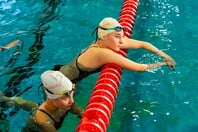Aπό την επαγγελματική μου εμπειρία αντιμετώπισης αραιο-αμηνορροικών αθλητριών (δρομείς-πυγμαχους-γυμνάστριες)με εξέπληξε πόσο μεγάλη άγνοια υπήρχε στους γονείς και τις αθλητριες για τα άλλα δύο συστατικά της τριάδας πέρα απο το εμφανές της απουσίας εμμηνορυσίας.Οι γονείς παθαίναν σοκ οταν η μέτρηση οστικής πυκνότητας (BMD εδειχνε Ζ-score -2,2 ή -2,4 και συνειδητοποιούσαν οτι η κόρη τους είχε οστο εμμηνοπαυσιακής .Ποιο επίπονη είναι η αναγνώριση των διατροφικών διαταραχών (δεν εκδηλώνουν όλες τυπικά κριτήρια anorexia ή bulimia nervosa).Όλες όμως είχαν περιορισμό προσληψης τροφής,εμμονή με το σωματικό βάρος και ελλειματικό θερμιδικό ισοζύγιο ακόμα και αν ΔΕΝ τις βοηθούσε στην εξέσκηση τους.Σου παραθέτω κάποια άρθρα αρκετά εκλαικευμένα αν θέλεις να το μελετήσεις . Female athlete triad and its components: toward improved screening and management.Mayo Clinic Procedures September 2013Low energy availablity, from either dietary restriction or increased expenditure, plays a pivotal role in development of the triad. Athletes involved in "lean sports" (those that emphasize weight categories or aesthetics, such as ballet, gymnastics, or endurance running) are at highest risk. Treatment is centered on restoring energy availability to reverse adverse changes in the metabolic milieu. Prevention and early recognition of triad disorders are crucial to ensure timely intervention. Caregivers and physicians of female athletes must remain vigilant in education, recognition, and treatment of athletes at risk. http://www.ncbi.nlm.nih.gov/pubmed/24001492Knowledge of the female athlete triad, and prevalence of triad risk factors among female high school athletes and their coaches.J Pediatr Adolesc Gynecol. 2014 Oct;http://www.ncbi.nlm.nih.gov/pubmed/25023979The prevalence of clinical eating disorders among female elite athletes ranges from 16% to 47%. The differences in prevalence rates among studies are likely related to variability in the sports studied (eg, weight class or aesthetic sports versus ball games), different screening methods (eg, questionnaires versus interviews), intensity and ages of athletes, and other methodological differences. However, the various prevalence rates of eating disorders in athletes are still in stark contrast to the 0.5% and 10% prevalence among nonathletic men and women in the general population.The Female Athlete Triad Sports Health. 2012http://www.ncbi.nlm.nih.gov/pmc/articles/PMC3435916/























